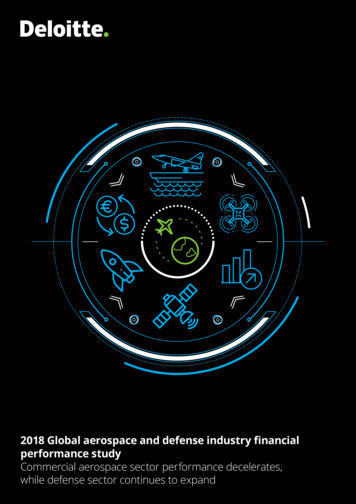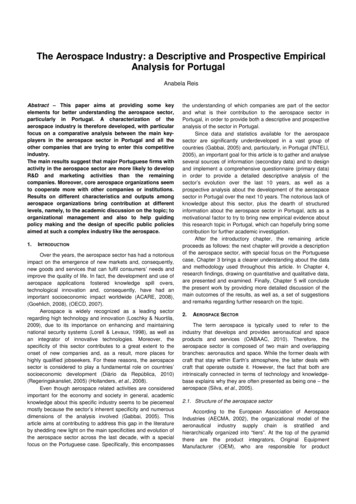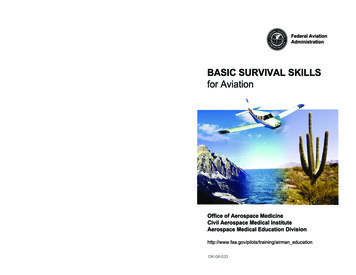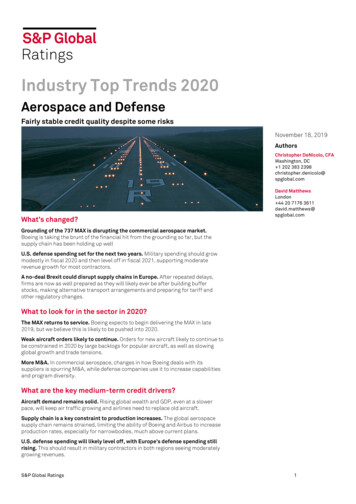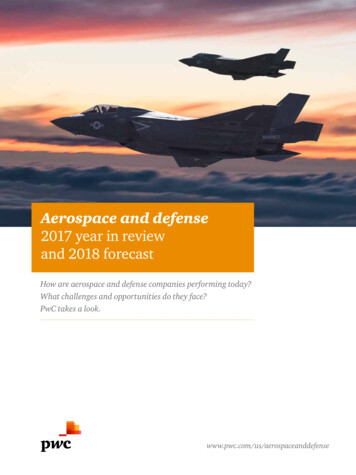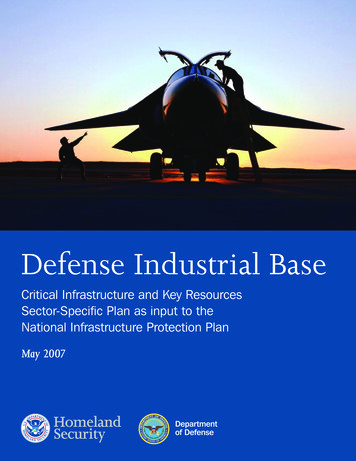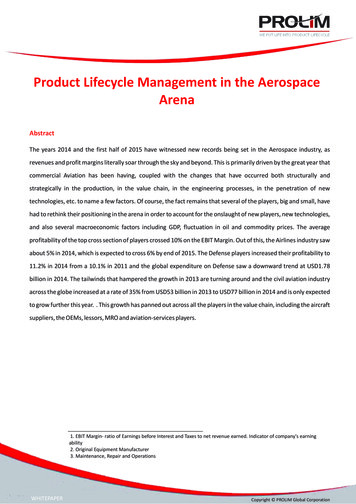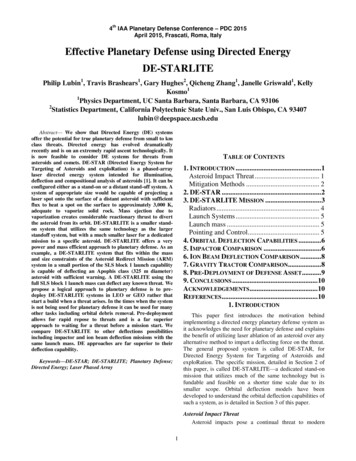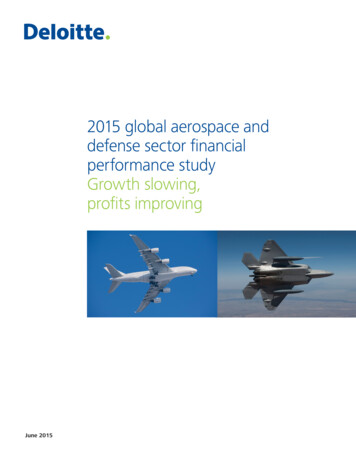
Transcription
2015 global aerospace anddefense sector financialperformance studyGrowth slowing,profits improvingJune 2015
Contents23Executive summary7Summary of key 2014 financial performance measures9Scope of the study12Detailed 2014 global aerospace and defense sector performance30U.S. compared with European aerospace and defense companies33U.S. compared with European defense subsector35Global commercial aerospace subsector performance compared withdefense subsector36Segment performance38Summary of aerospace and defense sector performance figures41Study methodology43Contacts
Executive summaryRevenue growth in the global aerospace anddefense sector is declining, with growth at a pacelower than gross domestic product (GDP) growth.Global aerospace and defense (A&D) sector revenuesgrew by 1.9 percent, adding US 12.7 billion in revenuesin 2014 to reach US 682.2 billion. This is a decline from3.2 percent growth in 2013 and 5.8 percent in 2012.Indeed, the overall sector growth was slower thanglobal gross domestic product growth of 2.6 percent in2014.1 Although revenues in the commercial aerospacesubsector continue to increase, defense subsector revenuescontinued to decline for the second consecutive year.Globally, the commercial aerospace subsector increasedrevenue by US 23.6 billion in 2014, an 8.2 percentincrease over 2013. However, this growth was offsetby revenue declines in the defense subsector of US 8.2billion or a 2.2 percent decrease from 2013 to 2014. Thekey take away is that all sector revenue growth and morehas resulted from increased revenues in the commercialaerospace subsector, similar to the last several years.Commercial aerospace subsector sets new recordsfor sales orders, deliveries, order backlogs, andrevenues, but the growth rate is expected to edgedown. Global commercial aerospace companies achievedthe highest levels of the four key growth metrics in thesector in 2014. Sales orders grew from 2,858 in 2013 torecord levels of 2,888 sales orders in 2014, while aircraftdeliveries increased by 6.1 percent from 1,274 to 1,352deliveries. However, the sector growth rate is expected toslow down to 3.0 percent, with a 2015 production levelexpected at 1,393 aircraft and 1,422 aircraft in 2016, for a2.1 percent growth rate. The sector’s 2014 order backloggrew by 14.4 percent and reached a record high of 12,175aircraft, compared to 10,639 aircraft in 2013. At thecurrent production rate, this represents a 9.0-year backlogof future production. Revenues grew by 8.2 percent, fromUS 291.2 billion in 2013 to US 314.9 billion in 2014.The Boeing Company and Airbus Group together addedUS 6.1 billion in additional revenue in 2014, as a followup to the US 11.0 billion of combined incremental growthin 2013. Growth in demand for travel, especially in China,India, and the Middle East, as well as the need for morefuel-efficient aircraft continue to drive demand for newaircraft sales. Because of this continued demand for newcommercial aircraft, it is estimated that over 34,000 jetsover the next 20 years will be produced, with a value ofover US 1.78 trillion at list prices.2United States (U.S.) defense subsector revenuescontinue to decline with the bottom expected nextyear. Defense subsector revenues in the U.S. have beenshrinking or remained stagnant for several years with flatgrowth in both 2013 and 2012, and a 2.5 percent declinein 2011. In 2014, revenues in the U.S. defense subsectordeclined by 2.2 percent or equivalent to US 5.4 billion.This is primarily due to the drawdown of large armedforces engaged in operations in the Middle East andcontinued declines in funding by the U.S. Department ofDefense (DOD), the largest sector customer whose budgetdecreased by 4.7 percent in 2014.3 Of the top 20 defensesubsector companies in the U.S., only six companiesexperienced revenue growth in 2014. The Budget ControlAct of 2011 mandated a reduction (sequestration) ofNote: Due to rounding, numbers presented throughout this report may not add up precisely to the totals provided and percentages may notprecisely reflect the absolute figures. Also, the total A&D sector revenues will not precisely match when commercial aerospace and defense revenuesare added together. This is because many large A&D companies have corporate eliminations/others as input in their total revenues, which cannot bedistributed among commercial aerospace and defense subsectors.The World Bank, Global Economic Prospects, January 2015, nomic-prospects.1The Boeing Company, Current Market Outlook (2014-2033), September 2014, f/BoeingCurrent Market Outlook 2014.pdf; and Airbus Group, Global Market Forecast (2014-2033), September 2014, ockholm International Peace Research Institute (SIPRI), SIPRI Military Expenditure Database, accessed on May 2015, x database.33
defense spending by about US 490 billion between U.S.government fiscal years 2012 and 2021.4 Although, theimpact of sequestration cuts tapered in 2014, followingthe enactment of The Bipartisan Budget Act in December2013, significant uncertainty remains concerning theoverall levels of defense spending for future years.5 Lawmandates future sequestration cuts. Unless the U.S.Congress changes it, procurement decisions could result infurther reductions, cancellations and/or delays of existingcontracts or programs. This is likely to adversely affect therevenues and cash flows of defense companies. However,it is likely that even with sequestration in effect, theDOD base budget will start to bottom out in 2016 withconsumer price inflation (CPI) adjusted increases starting totake effect.Profitability and margins continue to improve.Operating margins have been improving in the A&Dsector; 8.4 percent in 2012, 9.6 percent in 2013 and 9.8percent growth in 2014. The sector added US 2.2 billionin global operating profits, reaching a record US 66.7billion in 2014. Commercial aerospace grew earnings by6.0 percent. Defense companies grew earnings by 5.1percent despite the 2.2 percent revenue decline in 2014.Commercial aerospace margins were 10.2 percent, whiledefense companies were 9.7 percent in 2014.Top 20 company revenue rankings increasinglyreflect commercial aerospace subsector growth. Interms of 2014 sales revenue, GE Aviation has moved upthe list to the seventh spot as both Northrop Grummanand Raytheon have experienced declines in sales revenue,falling to eighth and ninth spots respectively. BombardierAerospace has also moved up in ranking to the sixteenthspot ahead of Textron. Spirit AeroSystems has made anentry into the top 20 list with a 14.1 percent increase inrevenues in 2014. The changes to the top 20 list of globalaerospace and defense companies continue to reflect therising fortunes of commercial aerospace players, includingsignificant revenue increases in the supplier base, whichhas resulted from commercial aircraft production growth.Additionally, it depicts the impact of declining growth inglobal defense spending over the last few years.The U.S. continues to outperform Europe inprofitability. Average operating margins for the U.S.and European companies were strong at 11.4 percentand 8.0 percent respectively. However, the U.S. showedimproved operating earnings performance compared tothe Europeans with a 9.8 increase in contrast to a declineof 2.0 percent from 2013 to 2014. This slower relativegrowth rate resulted mainly from continued below averageoperating performance by European companies comparedto their U.S. peers. This brings into focus the challenge forEuropean A&D companies to gain efficiencies in the costand asset base and their comparative ability to rationalizeassets and reduce operating expenses. In addition, withinEurope, country specific defense budgets supporting theindividual country industrial base may not be large enoughto achieve competitive efficiencies and economies of scalein their cost structure.Sector is becoming more efficient. The global A&Dsector has experienced improved operating efficiencies,resulting in higher earnings and operating margins asnoted above. Efficiency, defined as operating profitper employee among A&D companies increased fromUS 31,898 in 2013 to US 33,341 in 2014, a 4.5 percentimprovement. Indeed, employment growth in the sectorwas flat in 2014, holding at approximately 2.0 millionworkers. However, there were marked differencesbetween regions. For example, profitability per employeein Europe was US 26,335, while in the U.S. this wasUS 39,379, a 49.5 percent gap between the tworegions. Interestingly, while overall revenue declined inthe defense subsector, profitability improved due to abase of fewer employees, which significantly increasedemployee efficiency as measured by profit per employee.Commercial aerospace companies, especially largeentities, increased concentration of their supply base,risk sharing with suppliers, and factory automation, allof which improved the profitability per employee metric.Based on these positive trends in productivity, A&D sectorcustomers, such as airlines and their paying passengers,as well as the defense departments of countries, are likelyobtaining more for less, thus creating financial value forshareholders, taxpayers, and the global economy.A&D sector is becoming more commercial. Basedon increasing fortunes in the commercial aerospacesubsector and recent declines in the defense subsector,the overall makeup and character of the global A&D sectoris becoming more commercial. In 2013, 56.5 percent ofsector revenue was from defense, space, and security,The United States Office of the Under Secretary of Defense (Comptroller)/Chief Financial Officer, “Fiscal Year 2014 Budget Request and FY2013Update,” April 2013, s/defbudget/fy2014/FY2014 Budget Request Overview Book.pdf.45Ibid.2015 global aerospace and defense sector financial performance study4
while 43.5 percent originated from commercial aerospace.However, in 2014, the defense share of the sector droppedto 54.0 percent, while commercial aerospace increasedto 46.0 percent. This shift in sector concentrationdemonstrates a trend toward higher dominance by thecommercial aerospace subsector, as well as the long-termdecline of the defense subsector. Significant budgetarydelays and constraints have resulted in reduced defensespending levels, negatively affecting the revenue growthposition for the defense subsector. At the current rate ofgrowth, the commercial aerospace subsector is expectedto reach parity with the defense subsector in terms ofcontribution to total global A&D sector revenues for thefirst time within the next two years.Propulsion, avionics and tier two suppliers lead inprofit performance, while OEMs, aerostructuresand services profit lag. Similar to 2013, profitabilitywas uneven in the A&D supply chain. For example, engineand avionics suppliers demonstrated higher financialperformance due to efficiencies, scale economies, andhigher value integrated into their products such asincreased fuel efficiency, improved reliability, and lowermaintenance costs. On the other hand, governmentservices providers that perform systems engineeringand technical assistance and base and range staffaugmentation for government agencies generatedrelatively lower operating margins. Margins at propulsionor engine companies were 14.4 percent, while originalequipment manufacturers (OEMs) experienced 8.4 percentoperating margins in 2014.Key drivers of 2014 sector sales, revenue, andearnings growth. Financial performance in the globalA&D sector can be largely attributed to the sales growthin commercial airplanes at Boeing and Airbus, with abook-to-bill ratio of 2.76 times. This is expected to driverevenues for the sectors for years to come. As these5companies add to their sales orders, the backlog of orderscontinue to increase, which has resulted in increases inproduction build rates, which are at an all-time high.Indeed, The Boeing Company and Airbus Group aloneadded US 6.1 billion in additional revenues in 2014.On the other hand, as described earlier, the top 20 U.S.defense subsector companies have been on a downwardrevenue trend for several years, and in 2014 shrank as agroup by US 3.6 billion in revenues. Regarding profits, theU.S. has led the way with a combined US 4.1 billion inadditional operating profits. Figure 1 illustrates further thekey drivers of sector financial performance in 2014.
Figure 1: Summary of key drivers of A&D sector revenue and earnings performanceRevenue:In US billion Growth of The Boeing Company and Airbus Group 6.1 Contraction of the top 20 U.S. defense contractors- 3.6 Growth of propulsion segment 3.0 Growth of Tier one, Tier two, and Tier three suppliers 5.1 Contraction from services segment- 2.0 Contraction from electronics segment- 0.5 Other* 4.6 Total revenue growth 12.7 billionEarnings:In US billion Increased performance of the U.S. defense subsector 1.3 Increased performance of the U.S. commercial aerospace subsector 2.4 Increased performance of European defense subsector 0.4 Increased performance of European commercial aerospace subsector 0.9 Other*- 2.8 Total increase in operating earnings 2.2 billion* This includes differences due to our commercial versus defense analysis, and current exchange rates used. Constantexchange rates have been used for the overall sector analysis. The sector figures include some companies from outside ofU.S. and Europe regions from Brazil, Canada, Israel, Japan, Singapore, and South Korea. Companies from these regions arenot included in the “U.S.” and the “European” region totals, but have been included in “Other”.Source: Deloitte Touche Tohmatsu Limited’s (DTTL) Global Manufacturing Industry group analysis of the 100 major globalaerospace and defense (A&D) companies using public company filings and press releases. See methodology section forfurther information and definitions of financial metric, as well as company name, reports, and dates. Note that all figures arein US dollars.2015 global aerospace and defense sector financial performance study6
Summary of key 2014 financialperformance measuresRevenues: The global A&D sector’s revenue grew toUS 682.2 billion in 2014 representing an increase of 1.9percent or US 12.7 billion revenue increase. In 2014, theU.S. A&D companies’ revenues increased by 2.0 percentwith significant growth driven by Boeing CommercialAircraft, however tempered by revenue declines originatingfrom the top 20 U.S. defense companies. Meanwhilerevenues for European A&D companies grew around thesame pace at 1.5 percent increase, driven primarily byAirbus Group commercial aircraft deliveries. The originalequipment manufacturers (OEM) segment revenues werebifurcated. While The Boeing Company and Airbus Group’scommercial aerospace revenues grew by 13.2 percent and10.6 percent respectively in 2014, their defense revenuesdeclined by 7.0 percent and 4.2 percent respectively. Thisresulted in a combined total OEM segment growth of 1.6percent, reflecting the weighted impact of the defensecompany performance on the combined average.Return on invested capital (ROIC): Reported global A&Dsector ROIC for 2014 improved to 18.0 percent comparedto 17.3 percent in 2013, an improvement of 3.9 percent.Operating earnings: Reported global A&D sectoroperating earnings increased by 3.5 percent to US 66.7billion in 2014 from US 64.5 billion in 2013. U.S. A&Dcompanies’ reported operating earnings increased by9.8 percent in 2014 while European A&D companies’operating profits declined by 2.0 percent. While theServices segment’s operating earnings decreased by 27.3percent, the Aerostructures segment’s operating earningsgrew by 47.1 percent in 2014. OEM segment’s growthof 3.7 percent in operating earnings reflects the strongcommercial market, which also offsets declines in thedefense subsector.Book-to-bill ratio (BTB): As an indicator of futurefinancial performance, the global A&D sector BTB ratioincreased by 14.2 percent in 2014 to 1.51 times comparedto 1.32 times in 2013. This was likely due to significantsales order activity above existing production build ratesfor commercial aircraft companies. Airbus Group’s BTBratio increased by 30.0 percent in 2014, while The BoeingCompany’s BTB ratio increased by 8.2 percent. Bothcommercial aircraft producers have announced further rateincreases to turn sales orders into production and thereforerevenues at higher levels than in 2014.6Operating margins: Reported global A&D sectoroperating margins improved by 1.5 percent to 9.8 percentin 2014, from 9.6 percent in 2013. This was likely the resultof strong profit growth, especially in the Aerostructuressegment. U.S. A&D companies reported an 11.4 percentoperating margin in 2014, compared to 10.6 percent in2013. European A&D companies’ operating margin declinedslightly from 8.2 percent in 2013 to 8.0 percent in 2014.Free Cash Flow (FCF): Global A&D sector FCF increasedby 10.4 percent to US 53.0 billion in 2014, compared toUS 48.0 billion in 2013. This is likely the result of A&Dcompanies’ revenue and operating cash flow growth,especially in commercial aerospace, which was offsetby decreases in government defense spending andredeployment of cash for acquisitions.Free Cash Margin (FCM): Global A&D sector FCMimproved by 8.3 percent to 7.8 percent in 2014, comparedto 7.2 percent in 2013, impacted by a 10.4 percentincrease in FCF in 2014. The Boeing Company and GeneralDynamics combined results added US 1.1 billion FCF in2014, likely due to strong operational performance.Employment: The global A&D sector’s total globalemployment was essentially flat with a nominal decreaseof 1.0 percent to approximately 2 million in 2014. Flatgrowth in employment compared to increases in revenuesand earnings helped to boost the productivity in the globalA&D sector.Productivity: Reported operating earnings per employeein 2014 increased 4.5 percent to US 33,341 as the globalA&D sector’s total operating earnings rose by 3.5 percentcompared to a 1.0 percent decrease in sector employment.Deloitte Touche Tohmatsu Limited (DTTL) Global Manufacturing Industry group analysis of company annual report,May 2015. Please see “Study Methodology” section for further information.67
Figure 2 lists the companies that are ranked as the top performers in the 26 metrics among the top 100 global A&Dcompanies in this study, according to the methodology used for this report (see Methodology section for moreinformation). Although this is not a financial performance ranking, it does provide some visibility to the number of times aspecific company has been ranked with the highest performance in a given financial metric category.Figure 2: Top ranked company for each of the 26 key 2014 financial performance metricsMetricTop ranked company2014 resultRevenueThe Boeing CompanyUS 90,762 millionRevenue growthWesco Aircraft50.4%Operating earningsThe Boeing CompanyUS 7,473 millionOperating earnings growthManTech International Corp.333.3%Operating marginTransdigm Group39.1%Operating margin growthManTech International Corp.464.2%Return on invested capital (ROIC)Lockheed Martin39.8%ROIC changeManTech International Corp.1240.0%Free Cash Flow (FCF)The Boeing CompanyUS 6,622 millionFCF changeGenCorp/Aerojet Rocketdyne Holdings643.1%Free Cash Margin (FCM)Amphenol70.3%FCM changeGenCorp/Aerojet Rocketdyne Holdings643.1%Cash and cash equivalentsThe Boeing CompanyUS 11,733 millionCash and cash equivalents changeCurtiss-Wright156.8%Book-to-bill (BTB) ratioAirbus Group3.94 timesBTB changeAlion Science & Technology Corp436.8%BacklogAirbus GroupUS 1,068,250 millionBacklog changeKorea Aerospace Industries218.9%Number of A&D employeesThe Boeing Company165,529Employee additionsGeneral Dynamics3,500Employee additions growthWesco Aircraft99.4%Revenue per employeeFuji AerospaceUS 797,067Revenue per employee growthExelis68.7%Operating profits per employeeTransdigm Group Inc.US 119,542Operating profits per employee growthManTech International Corp.376.1%Share price changeJAMCO Corporation108.4%Source: DTTL’s Global Manufacturing Industry group analysis of the 100 major global A&D companies using public companyfilings and press releases. See methodology section for further information and definitions of financial metric, as well ascompany name, reports, and dates. Note that all figures are in US dollars.2015 global aerospace and defense sector financial performance study8
Scope of the studyThe DTTL Global Manufacturing Industry group’s 2015global aerospace and defense sector financial performancestudy analyzes the top global 100 A&D companies orbusiness units of industrial conglomerates with A&Dbusinesses that reported revenue of more than US 500million in 2014 with financial statements filed by 31December 2014 unless otherwise specified. Figure 3 belowlists the 100 companies and divisions that were analyzed.The study, however, does not include A&D organizationssuch as government-controlled entities, private companiesthat do not release public filings or public companiesthat do not report A&D business segment information.In addition, certain companies from the previous year’sstudy were excluded likely due to conformance with studycriteria. That is, companies from previous years with 2014revenues less than US 500 million in revenue, companiesfrom previous years that have been subsequently acquired,and companies from previous years lists that have or aregoing private, were not included in the 2014 analysis.Please refer to the Methodology section for furtherinformation that includes the company information usedto complete this study.9The study was conducted by assessing performance basedon calculating 26 key financial metrics. These includekey nominal and growth metrics for revenue, operatingearnings, operating margin, return on invested capital(ROIC), free cash flow (FCF), free cash margin (FCM), bookto-bill (BTB) ratio, employee productivity, and equity marketperformance. All financial metrics in the study are basedon a constant currency conversion method to eliminate theimpact of foreign exchange fluctuations on companies’ orthe global A&D sector’s performance.Financial performance metrics at the company levelare cited throughout this study, especially for the topperforming companies and selectively for the lowerperformers. However, unique metrics for a given companyshould not be viewed in isolation, as there typically areunique transactions for individual metrics by company,e.g., prior year acquisitions, special circumstances, etc. Thecombined metrics for a given company, taken as a whole,are more likely to form the basis for an overall assessmentof the financial performance of the global A&D sector, aswell as individual companies.
Figure 3: A&D companies included in the analysisA&D companies or divisions included in this study ranked by 2014 sales revenue1. The Boeing Company2. Airbus Group3. Lockheed Martin4. United TechnologiesCorporation*5. General Dynamics6. BAE Systems plc7. GE Aviation*8. Northrop Grumman9. Raytheon10. Safran11. Honeywell Aerospace*12. Thales13. Finmeccanica14. Rolls-Royce15. L3 Communication16. Bombardier Aerospace*17. Textron18. Mitsubishi Heavy IndustriesAerospace*19. Huntington Ingalls Industries20. Spirit Aerosystems21. Embraer22. Precision Castparts Corp.23. Zodiac Aerospace24. MTU Aero Engines25. Singapore TechnologiesEngineering Ltd.26. Rockwell Collins27. Dassault Aviation28. Orbital ATK29. Babcock International30. Leidos Holdings Inc.31. IHI Aero Engine & Space*32. Triumph Group33. SAIC34. GKN Aerospace*35. SAAB36. Harris Corp.37. Exelis38. Kawasaki Aerospace andGas Turbines*39. Cobham40. Rheinmetall Defence*41. Elbit Systems42. B/E Aerospace43. CACI44. ThyssenKrupp Marine Systems*45. Parker Hannifin Aerospace*46. CSC*47. BBA Aviation48. Jacobs Engineering Group*49. Transdigm Group50. Meggitt51. Korea Aerospace Industries52. Serco Defence*53. QinetiQ54. AAR Corp55. MacDonald, Dettwiler andAssociates56. Eaton Aerospace*57. CAE Inc.58. Oshkosh Defense*59. Esterline Technologies60. ManTech International Corp.61. MOOG62. Hexcel63. GenCorp/Aerojet RocketdyneHoldings64. Allegheny Technologies*65. Samsung Techwin*66. Engility67. Wesco Aircraft68. Fluor Corp.*69. Curtiss-Wright70. DynCorp*71. Fuji Aerospace*72. HEICO Corporation73. Woodward Aerospace*74. Cytec Industries75. OHB Technology76. Amphenol*77. Ultra Electronics78. URS/AECOM*79. Ball Aerospace*80. Senior Aerospace81. LISI Aerospace*82. Kratos Defense &SecuritySolutions83. Smiths Detection*84. Latecoere85. Alion Science & TechnologyCorporation86. Cubic Corp.87. RTI International Metals88. Chemring89. Crane Aerospace andElectronics*90. Magellan Aerospace91. Kongsberg Defence Systems*92. Indra Sistemas*93. DigitalGlobe Inc*94. Teledyne Technologies*95. Kaman Aerospace*96. JAMCO Corporation97. SKF*98. Ducommun99. Navistar*100. KBR** Partial company results based on A&D activity, identified by A&D specific business segment where possible.Source: DTTL’s Global Manufacturing Industry group analysis of the 100 major global A&D companies using public company filings and press releases. Seemethodology section for further information and definitions of financial metric, as well as company name, reports, and dates.Summary of A&D sector performance: Figure 4 summarizes the key performance metrics of the global A&D sector in constant currency, thereby eliminatingpotential distortions caused by foreign currency fluctuations. All metrics are based on reported filings. Each performance metric is discussed in detail in this study.2015 global aerospace and defense sector financial performance study10
Summary of A&D sector performance: Figure 4summarizes the key performance metrics of the global A&Dsector in constant currency, thereby eliminating potentialdistortions caused by foreign currency fluctuations. Allmetrics are based on reported filings. Each performancemetric is discussed in detail in this study.Figure 4: Average performance of Global A&D companies in 2014, as compared to 2013Metric20142013Change (2014 versus 2013)Revenues (US billion)US 682.2US 669.41.9%Operating earnings (US billion)US 66.7US 64.53.5%Operating margin (percent)9.8%9.6%1.5%ROIC (percent)18.1%17.3%3.9%US 53.0US 4810.4%FCF margin (percent)7.8%7.2%8.3%BTB ratio1.51x1.32x14.2%A&D revenue/employee (US )US 340,668US 330,8873.0%A&D operating profit/employee (US )US 33,341US 31,8984.5%Number of A&D employees2,002,6692,023,237-1.0%FCF (US billion)Source: DTTL’s Global Manufacturing Industry group analysis of the 100 major global A&D companies using public companyfilings and press releases. See methodology section for further information and definitions of financial metric, as well ascompany name, reports, and dates. Note that all figures are in US dollars.11
Detailed 2014 global aerospaceand defense sector performanceThe following sections discuss the 2014 financialperformance of the global A&D sector based on companytype and geography, as well as on a consolidated basis: 2014 A&D sector performance details U.S. and European A&D companies Commercial aerospace and defense subsectorcompanies Sector performance comparisonsRevenue: Global A&D sector revenues grew 1.9 percentto US 682.2 billion in 2014 from US 669.4 billion in 2013(see Figure 5). This was driven primarily by another yearof record commercial aircraft production, which resultedfrom strong revenue growth for The Boeing Companyand Airbus Group. Although the global A&D sectoradded US 12.7 billion to sector revenue, revenue growthrate declined in 2014, from 3.2 percent to 1.9 percent.The U.S. defense subsector significantly contributed todecreased overall global growth in revenues, with the top20 U.S. defense contractors’ revenues declining US 3.6billion, or 1.7 percent. This decline was likely drivenby continued decreases in funding outlays by the U.S.Department of Defense, the largest subsector customer,whose budget decreased by 4.7 percent in 2014. Of thetop 20, only six U.S. defense contractors experiencedrevenue growth.However, The Boeing Company and Airbus Group togetherdelivered 1,352 aircraft in 2014, the largest number incommercial aircraft history. The continued increase inproduction is driving parallel revenue growth for tierone and tier two suppliers and the aerostructures andpropulsion segment companies.The Boeing Company, the largest global A&D companyin terms of revenues, reported a 4.8 percent increase inrevenues to US 90.8 billion in 2014 (see Figure 6) fromUS 86.6 billion in 2013, likely due to increased newaircraft deliveries from its Commercial Airplanes division.Boeing Commercial Airplanes’ revenues increased 13.2percent as the company delivered 723 aircraft in 2014(including 485 of the 737s and 114 of the 787s) comparedto 648 aircraft in 2012. Boeing’s Defense, Space, andSecurity division reported revenues of US 30.9 billion,down 7.0 percent year on year. The second largest globalA&D company, Airbus Group (see Figure 8), increasedrevenues 2.5 percent in 2014 to US 80.7 billion. Thecompany delivered 629 aircraft in 2014 including 490 ofthe A320 family and 30 A380s. The third largest company,Lockheed Martin, experienced a slight revenue increaseof 0.5 percent year over year (YoY) to US 45.6 billion, ascompared to US 45.4 billion in 2013. Product sales, whichconstitute 80 percent of the company’s net sales, grew 1.0percent YoY in 2014 due to increased aircraft deliveries,primarily F-16s.These three companies accounted for 31.8 percent ofthe total A&D sector revenues in 2014 (compared to 31.5percent in 2013), and therefore have a disproportionateimpact on the performance of the overall sector revenues.Revenues of the top 20 global A&D companies accountedfor nearly 75.6 percent of the global
defense sector financial performance study Growth slowing, profits improving June 2015. 2 Contents . 3 Stockholm International Peace Research Institute (SIPRI), SIPRI Military Expenditure Database, accessed on May 2015, . Company. Book-to-Bill ratio.
